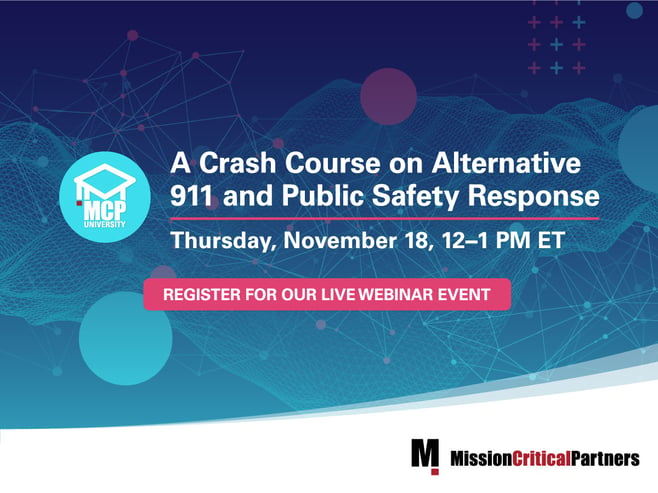911 Telecommunicators Need Help and Alternative Responses Are Part of the Solution
Posted on November 10, 2021 by Bonnie Maney
Emergency communications centers (ECCs) — also known as public-safety answering points (PSAPs) —handle an enormous volume of 911 calls, about 240 million annually nationwide. This figure is expected to rise significantly over the next few years, driven by smartphones, alarm systems, and internet of things (IoT) devices (e.g., wearable medical monitors).
As call volumes rise, telecommunicators who already are short/understaffed, undertrained, and under siege in many ECCs will be subject to even greater pressures as they work to send the correct response in the shortest amount of time. Fortunately, ways exist to relieve these pressures, and many agencies are exploring how they can strengthen and diversify how they respond to calls for service, both 911 and non-emergency.
A significant number of calls do not require traditional police, fire, or emergency medical services (EMS) responses. Communities across the nation are learning that other government and community entities can respond and support various non-emergency situations. These alternative responses can deliver the appropriate response faster, increase community engagement, decrease the risk to public safety personnel and citizens, and, most importantly, save more lives and keep communities safer.
More Than Mental/Behavioral Health and Social Issues
To be truly effective and have an impact, the definition of alternative response needs to be broadened to include more than just responses to mental/behavioral health and social issues affecting communities. Potential alternative response solutions also include technical, operational, and policy-driven approaches that improve operational efficiencies. This broader approach can contribute to a healthy ECC workforce that has the bandwidth to focus on the lifesaving mission rather than answering local government lines after hours, for example.
Key elements include:
- Identifying and reducing mission creep
- Automating manual workflows
- Incorporating alternative resources into the ecosystem
The following are some of the strategies being taken by agencies across the country to address these elements:
Leverage 211, 311, and 10-Digit Non-Emergency Lines for Municipal Departments
These resources can address mission creep that has occurred because of the ECC’s 24x7 availability, by redirecting calls to numbers that might be more appropriate for a particular circumstance. Using them would prevent unnecessary consumption of a 911 telecommunicator’s time. Such lines:
- Reduce incoming call volume
- Improve the caller experience
- Increase the telecommunicator’s ability to focus on emergency calls
Leverage Automated Solutions
Such solutions automate manual processing of calls for service involving repetitive or standard information that do not require contact with a 911 telecommunicator. Examples include ASAP-to-PSAP solutions or alternatives; online reporting software pertaining to repossessed, impounded, and towed vehicles; and options for handling low-acuity calls. Automated solutions:
- Decrease an ECC’s incoming call volume and call-answering times
- Improve caller access to appropriate services at first contact
- Reduces demand on limited 911 telecommunicator resources
Integrate Alternative Resources Into the Ecosystem
ECCs receive a large number of low-acuity medical calls, e.g., sprains, flu-like symptoms, a minor cut requiring stitches, stomach pains, which do not qualify as basic life support (BLS) or advanced life support (ALS) incidents. Nevertheless, ECCs are obligated to dispatch an ambulance/emergency medical technician (EMT)/paramedic to the incident to assess the patient’s condition and, in many cases, transport the patient to an emergency room (ER). The former is required regardless of the severity of the incident.
Another approach would be to establish a nurse-triage line managed by a third-party healthcare provider. When a 911 call is placed, it first would be fielded by a 911 telecommunicator. If it is a medical call, the telecommunicator, using prescribed protocols, would determine whether the call should be transferred to a registered nurse for triage. If so, the nurse will ask the caller another series of protocol-based questions.
The nurse then determines the appropriate medical care for the caller. In some instances, the nurse will work with the patient to schedule a visit with his/her primary care physician and arrange transport via a taxi, ride-sharing service, or a family member. If it is determined that the caller should be given immediate care, the call will be transferred back to 911 and a telecommunicator will dispatch an ambulance and any other appropriate response. While 911 telecommunicators still are involved in the calls, transferring low-acuity calls to the nurse frees 911 telecommunicators to handle other calls, reducing response times.
On November 18 at 1:00 PM ET, I will be presenting an MCP webinar on this topic that will do a deeper dive into these tactics and more. I urge you to register for this event by clicking here. In the meantime, we would welcome an opportunity to help you develop and leverage an alternative-response strategy — please reach out.

Bonnie Maney is an MCP enterprise client manager and operations lead. She can be emailed at BonnieManey@MissionCriticalPartners.com.


